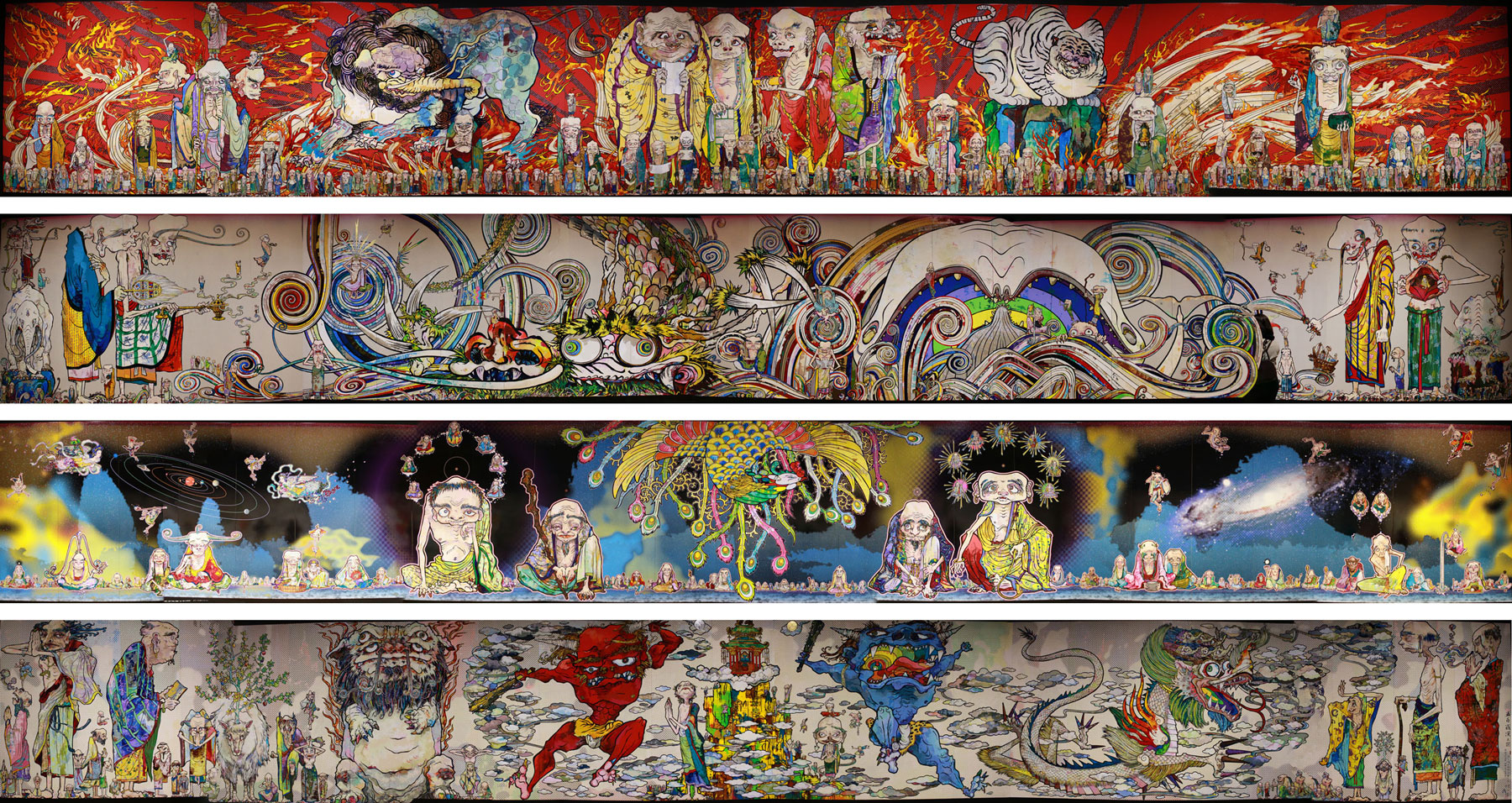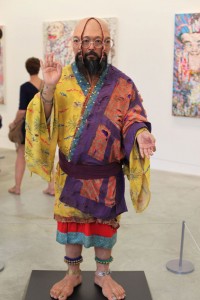TRACES: Takashi Murakami
 Today is the occasion to bear in mind an artist known as the Japanese Andy Warhol, Takashi Murakami (1/2/1962- ), who sience the early 1990s has invented characters that combine aspects of popular cartoons from Japan, Europe, and U.S.A., from his first Mr. DOB, who sometimes serves as a stand-in for the artist himself, to various anime characters and smiling flowers, bears, and lions. These figures act as icons and symbols—hosts for more complex themes of violence, technology, and fantasy. This column is a tribute to artists, living or dead, who have left their mark in Contemporary Art. Through documents or interviews, starting with: moments and memories, we reveal out from the past-unknown sides of big personalities, who left their indelible traces in time and history…
Today is the occasion to bear in mind an artist known as the Japanese Andy Warhol, Takashi Murakami (1/2/1962- ), who sience the early 1990s has invented characters that combine aspects of popular cartoons from Japan, Europe, and U.S.A., from his first Mr. DOB, who sometimes serves as a stand-in for the artist himself, to various anime characters and smiling flowers, bears, and lions. These figures act as icons and symbols—hosts for more complex themes of violence, technology, and fantasy. This column is a tribute to artists, living or dead, who have left their mark in Contemporary Art. Through documents or interviews, starting with: moments and memories, we reveal out from the past-unknown sides of big personalities, who left their indelible traces in time and history…
By Dimitris Lempesis
 Takashi Murakami was born in tokyo. Murakami’s father was a taxi driver, and his mother was a homemaker. His mother, who studied needlepoint and designed textiles, had a tremendous influence on Murakami’s interest in the arts. During Murakami’s childhood, Japan created a national identity that revived traditional Japanese culture and put tremendous pressure on its workforce to produce in order to compete with the West both economically, as well as culturally. This hybrid emphasis on traditional Japanese culture and Western influences was reflected in Murakami’s childhood activities, which ranged from attending Buddhist rituals and taking Japanese calligraphy courses to visiting museum exhibitions of masters such as Renoir and Goya. Though he developed an early appreciation of both traditional Japanese culture and modern European art, Japanese animation had the most significant impact on him during his formative teenage years. Initially interested in studying background art for animations, in 1980 Murakami enrolled in the Nihonga (a traditional Japanese painting style that draws on elements of Western art) department of the Tokyo National University of Fine Arts and Music, where he stayed on for master’s (completed in 1988) and doctoral degree (completed in 1993). While diligently studying the ancient techniques at university, he also learned animation production outside of school, and continued his knowledge of the contemporary art world through visiting exhibitions and his school’s visiting artist program. In 1984, an inspiring yet infuriating meeting with Joseph Beuys proved to be a turning point in Murakami’s artistic career. Murakami’s early works reflect the realities with which he had grown up, exploring the complex post-WWII relationship between Japan and the U.S. For example, “Polyrhythm” (1991) uses plastic World War II toy soldiers, “Sea Breeze” (1992) refers to the atomic bomb. These works demonstrate his early development of a playful and seemingly light style that always refer to a more cynical stance. In 1994, Murakami traveled to New York City to participate in P.S.1 Contemporary Art Center’s International Studio Program on a fellowship from the Asian Cultural Council. Isolated and fairly unhappy in New York, Murakami was surrounded by the pressures of the American art market and gallery system. There he realized that in order to succeed in this world, he had to abandon his overly-intellectual Japanese preoccupations, and to present a more simplified brand of himself and his art as quintessentially Japanese. This time therefore represents a radical breaking point for his career. Prior to this, his work focused on a global bent to contemporary art, but it was during this visit that he decided to re-engage with his Japanese identity and strengthen his work’s engagement with both the high art form of Nihonga as well as the popular culture forms of anime and manga.
Takashi Murakami was born in tokyo. Murakami’s father was a taxi driver, and his mother was a homemaker. His mother, who studied needlepoint and designed textiles, had a tremendous influence on Murakami’s interest in the arts. During Murakami’s childhood, Japan created a national identity that revived traditional Japanese culture and put tremendous pressure on its workforce to produce in order to compete with the West both economically, as well as culturally. This hybrid emphasis on traditional Japanese culture and Western influences was reflected in Murakami’s childhood activities, which ranged from attending Buddhist rituals and taking Japanese calligraphy courses to visiting museum exhibitions of masters such as Renoir and Goya. Though he developed an early appreciation of both traditional Japanese culture and modern European art, Japanese animation had the most significant impact on him during his formative teenage years. Initially interested in studying background art for animations, in 1980 Murakami enrolled in the Nihonga (a traditional Japanese painting style that draws on elements of Western art) department of the Tokyo National University of Fine Arts and Music, where he stayed on for master’s (completed in 1988) and doctoral degree (completed in 1993). While diligently studying the ancient techniques at university, he also learned animation production outside of school, and continued his knowledge of the contemporary art world through visiting exhibitions and his school’s visiting artist program. In 1984, an inspiring yet infuriating meeting with Joseph Beuys proved to be a turning point in Murakami’s artistic career. Murakami’s early works reflect the realities with which he had grown up, exploring the complex post-WWII relationship between Japan and the U.S. For example, “Polyrhythm” (1991) uses plastic World War II toy soldiers, “Sea Breeze” (1992) refers to the atomic bomb. These works demonstrate his early development of a playful and seemingly light style that always refer to a more cynical stance. In 1994, Murakami traveled to New York City to participate in P.S.1 Contemporary Art Center’s International Studio Program on a fellowship from the Asian Cultural Council. Isolated and fairly unhappy in New York, Murakami was surrounded by the pressures of the American art market and gallery system. There he realized that in order to succeed in this world, he had to abandon his overly-intellectual Japanese preoccupations, and to present a more simplified brand of himself and his art as quintessentially Japanese. This time therefore represents a radical breaking point for his career. Prior to this, his work focused on a global bent to contemporary art, but it was during this visit that he decided to re-engage with his Japanese identity and strengthen his work’s engagement with both the high art form of Nihonga as well as the popular culture forms of anime and manga.
On the eve of his departure from New York, while playing a late-night word game with friends using non-sense words, Murakami came up with the figure Mr. DOB, which would go on to become the artist’s signature character across his diverse array of artistic media. Mr. DOB-shaped inflatables were shown for the first time in New York at the Angel Orensanz Foundation in 1995, but did not receive any significant critical attention. In 1996, he was included in a group exhibition at the gallery Feature. This exhibition marks the beginning of his international acclaim and fame. Murakami went on to design a series of major sculptures inspired by otaku subculture in the second half of the nineties, including “Miss ko2” (1996-97), “Hiropon” (1997), and “My Lonesome Cowboy” (1998). Murakami’s liberal borrowings from Japanese popular culture was very comparable to Roy Lichtenstein and Andy Warhol’s appropriations of comics. In order to produce his otaku-inspired sculptures, in 1996 Murakami founded the Hiropon Factory. Like much of Murakami’s works, his factory is modeled on both traditional Japanese art workshops, such as the ones that produced the colorful woodblock prints from the Edo period, as well as on Andy Warhol’s Factory. In 2001, the Hiropon Factory evolved into Kaikai Kiki Co., a highly organized corporation employing about fifty people in its Tokyo headquarters, and twenty in its New York office and studio. Besides producing and marketing Murakami’s works, the corporation promotes new artists; operates art fairs, organizes collaborative projects with individuals and companies in fashion, music, and entertainment, and develops animated videos and films In 2000, in search of a post-war Japanese identity and out of a frustration of his compatriots’ indifference to Japanese contemporary art, Murakami presented the theory of Superflat in a group exhibition of the same name. The exhibition featured his own works as well as the ones by Yoshitomo Nara, Shigeyoshi Ohi, Aya Takano, and others. The Superflat theory soon swept across the contemporary art world, becoming a landmark movement in contemporary Japanese art, the latest major style to reach international acclaim in the art world since the 1950s Japanese Gutai group. Murakami’s historic essay, “A Theory of Super Flat Japanese Art” (2000) is his ultimate expression of his early scorn for the art world. There, he articulates desire to produce a uniquely Japanese art form that is directly related to the long shadow cast by Japan’s trauma after the humiliating defeat of WWII. Ever since the founding of the Hiropon Factory, Murakami’s projects have been more commercially charged and have explored unconventional artistic media including fashion, music, entertainment, public installations, animation, and films. This shift between roles reveals Murakami’s ambition of redefining what a postmodern, international artist can be. In 2002 he began a multiyear collaboration with Marc Jacobs on the redesign of the Louis Vuitton monogram. Murakami then took the radical step of directly incorporating the Vuitton monograms and patterns into his paintings and sculptures. While Murakami’s imagery may appear to present unprecedented characters and forms, many contain explicit art historical references, and some are even direct contemporary updates on traditional Japanese works. In 2009 Murakami and the esteemed art historian Nobuo Tsuji began a creative dialogue centered on a group of Japanese artists known as the Edo eccentrics. This collaboration led to an exhibition at the Museum of Fine Arts in Boston in 2017, for which Murakami and Tsuji selected Japanese works from the museum’s collection and showed them alongside works by Murakami. The latter included “Dragon in Clouds—Red Mutation: The version I painted myself in annoyance after Professor Nobuo Tsuji told me, “Why don’t you paint something yourself for once?” (2010), a red monochrome version of the famous eighteenth-century painting “Dragon and Clouds” by Soga Shōhaku. Following the Tōhoku earthquake of 2011 and the subsequent nuclear crisis at Fukushima, Murakami began deeply exploring the impact of historical natural disasters on Japanese art and culture. In his 2014 exhibition at Gagosian Gallery in New York, he created an immersive installation of eclectic arhats; deliquescing clones of his fictional creature Mr. DOB; and karajishi, the mythic lions that guard Japanese Buddhist temples, that visitors entered through a replica of a sanmon (sacred gate).










